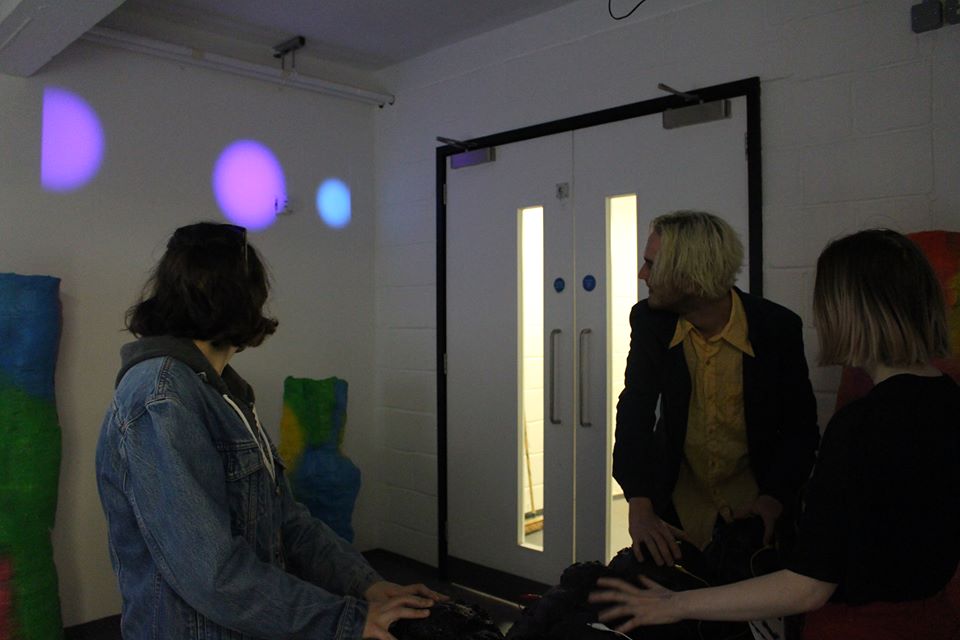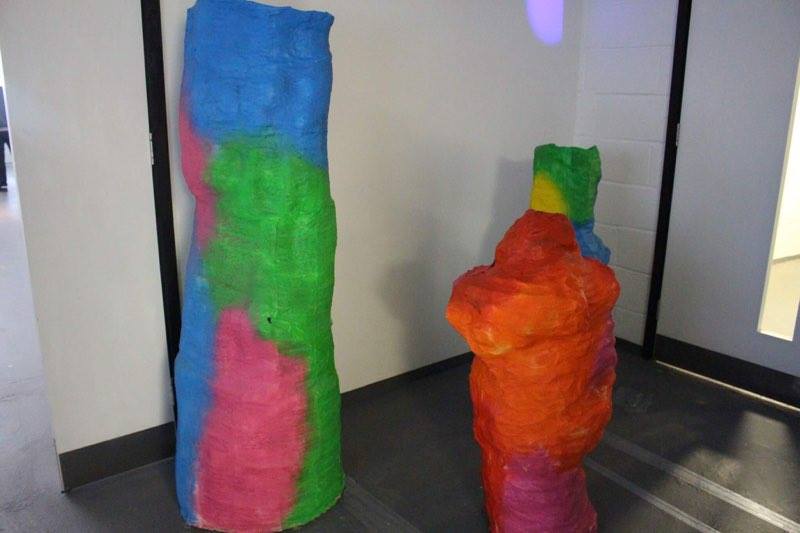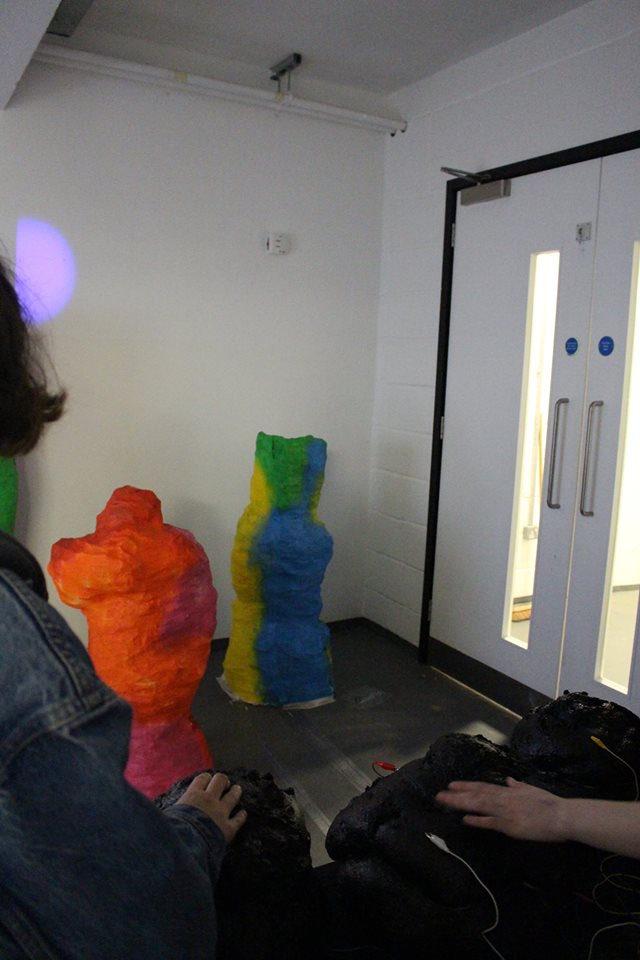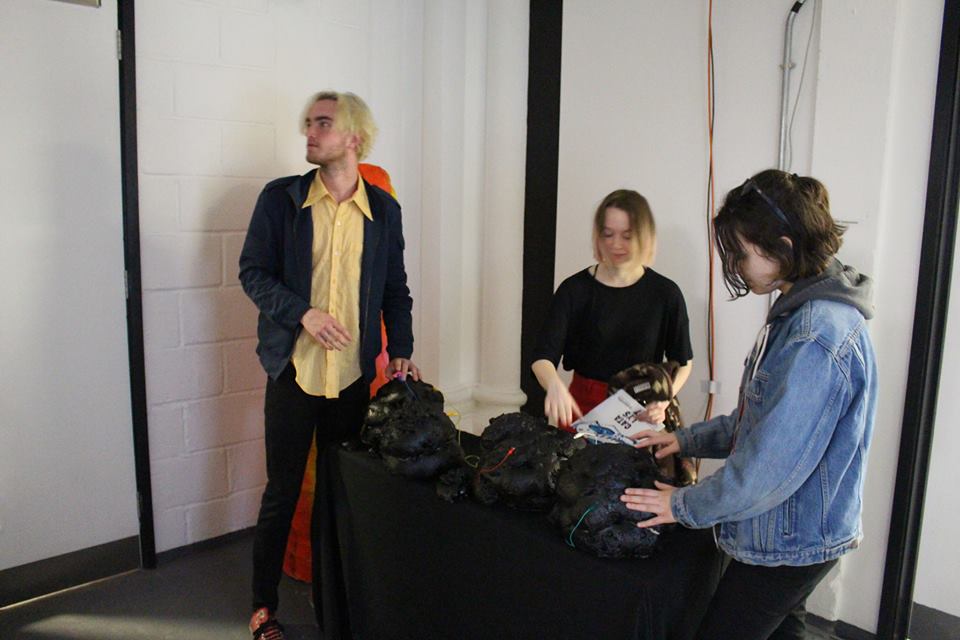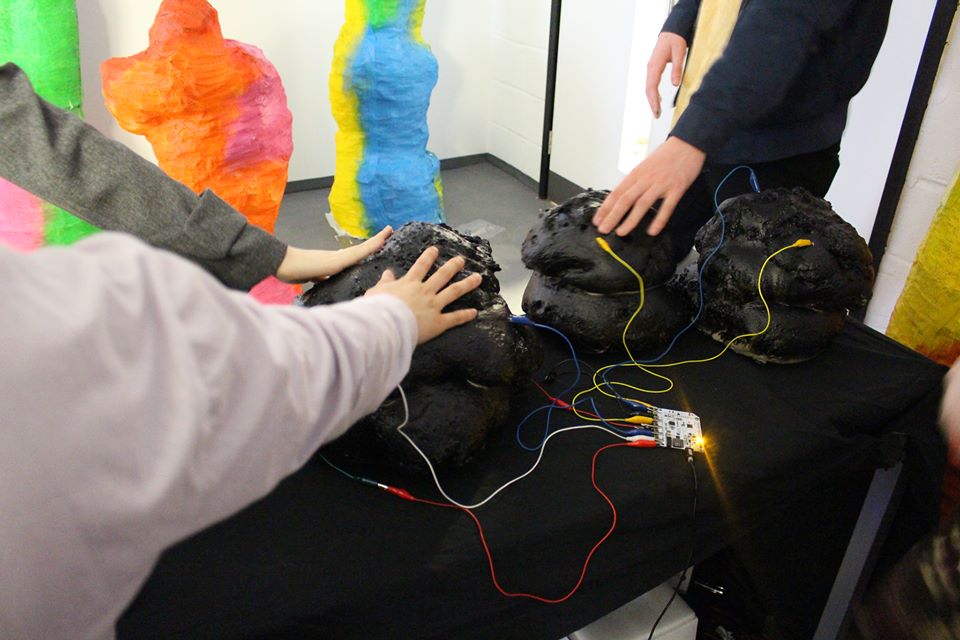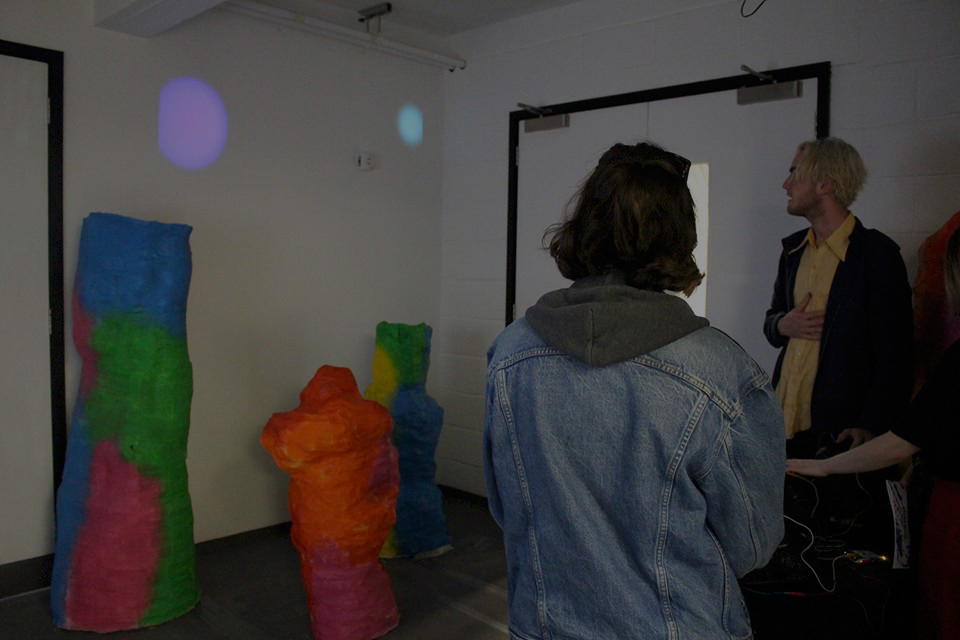

Post Magma
by: Charlotte Oppenheim
Post Magma was an interactive installation that involved sculptures with capacitive touch technology. The touch sensors caused programmed visuals and sound to be created, and viewed on a projected screen. The sculptures appear as natural forms similar to rocks, but made colourful, while the interactive rocks are black. This was due to the fact that I needed to get a good reading from the electrodes by using exposed conductive paint, which is black.
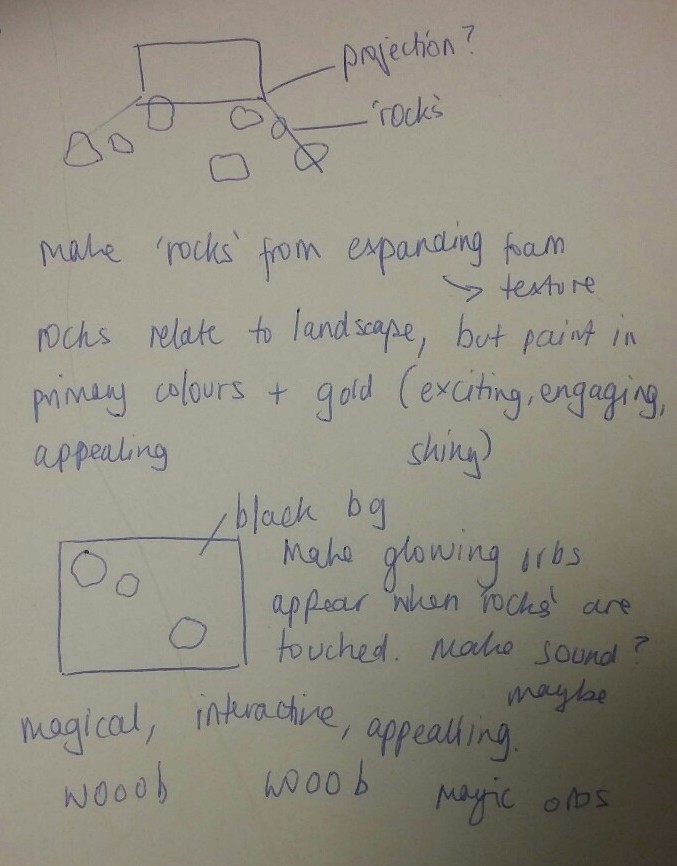

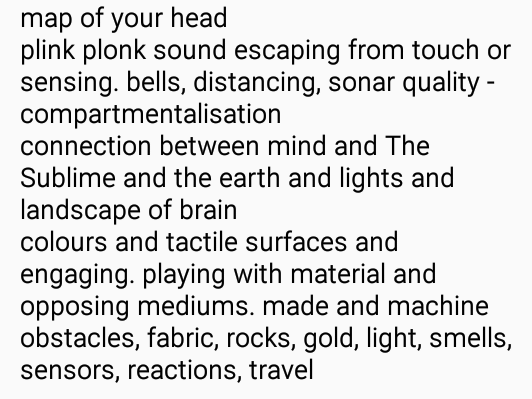

I wanted the installation to appear natural yet unnatural. I found the exhibition space to offer quite a juxtaposition to my ideas; it is a very manufactured area, adorned with pipes and wires and other things to offer a view into the reality outside of any artwork placed in it. I invited people to explore the landscape created by the sculptures in addition to the sculptures themselves through touch. My plans were to have a large area for the sculptures to inhabit so they could be well spaced, while also using a large wall to project onto, therefore creating an immersive environment. I wanted the audience to navigate their way around the valleys that had been created by the tall rock-like shapes, which is why I wanted a large space, as if learning where to place their feet, like they did as growing, learning children. In ‘An Essay Concerning Human Understanding (1689)’[1], John Locke discusses the ways in which ‘a posteriori’ experiences could be considered more sensually valuable, this is relevant when I refer to my work. I didn’t want something that wasn’t immersive or static, I wanted the space to change when an audience was involved.
I had a lecture on ‘the Sublime and the Beautiful’, in which the lecturer discussed controlled environments such as gardens and parks that became popular in the Romantic era, and the almighty power of raw nature in comparison; which is what would be considered to be the contrast between what is classed as sublime and what is beautiful. During this lecture, I had thoughts about the mind being a landscape that we try to manipulate into working for us, as people began to do in pursuit of perfect beauty, despite the synapses and chemicals in ours mind being mainly out of our control. Personally, I was experiencing a lot of problems with dissociation and compartmentalisation, which can alienate oneself from their own mind. I found myself having to learn about this incomprehensible space in my head in order to recover memories and thoughts about myself and the world around me. “Trauma brings about a dissociation of affects and representation: one disorientingly feels what one cannot represent; one numbingly represents what one cannot feel.”[2] This can also be put in the context of the sublime with an analysis of Romantic poet Percy Bysshe Shelley’s work: “In Shelley’s ‘Mont Blanc’ the boundaries between mind and nature are deliberately blurred…[it] is defiantly remote and ‘inaccessible’”[3].
Although the idea of the landscape came from concepts about the sublime in nature, I wanted to make reference to ways that we learn as a child. “High-contrast patterns and bright colours will captivate your baby because they're the easiest for her to see…She won't be able to hold toys for a while, but she'll show her preferences by batting at the ones she likes…High-contrast toys in these colours help your baby pick out the differences in shapes and patterns, stimulating her visual development.”[4] It is quite well known from observation that babies and young children are attracted to bright and contrasting colours, which has been proved through research into their sight and perception. However, I didn’t want anything to appear stark or at all sharp because “newborn vision has been described as if looking through a dense fog”[5], which I thought was an interesting way of experiencing things. The sound involved in the piece was inspired by a discussion I had with a friend about experiencing regression. Regression[6] occurs mainly through hypnotherapy, as it allows for people to understand their own past experiences as part of their personal development. I was told about things people have heard, and most people have described it as being underwater, or being in a bubble. I thought returning the space to a primordial field would aid in the sense of immersion into a separate zone from reality. This was also helped by the dim lights.
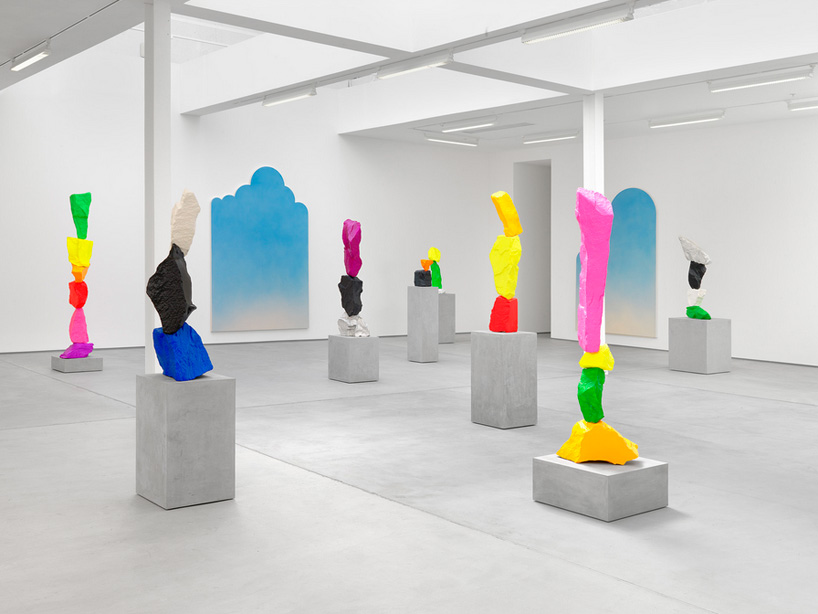

I had seen the “clouds + mountains + waterfalls” exhibition of Ugo Rondinone’s work long before working on this project, but it inspired a lot of aspects of my work. The work shown in this exhibition contained geological sculptures that evoked some abstraction due their colouring and suspended formation. The sculptures were aesthetically interesting, but also withheld a lot of possible metaphors, due to the combination of natural forms and painterly qualities. In the press release for the exhibition, the mountain sculptures were described as possibly “veering towards anthropomorphism”[7], which I feel also applies to my own similar sculptures. Thinking of these child-like experiences and the large physical natural forms, I saw a timid quality in the sculptures and the action of touching, I really enjoyed them.
I also took a lot of interest in a group called ejtech[8], who work a lot with capacitive touch and sound, and using natural forms. I feel like in the future, I want to push this idea of natural form in digital works, as it makes an interesting juxtaposition, but can also contain many conversations the environment and metaphors linked with nature.
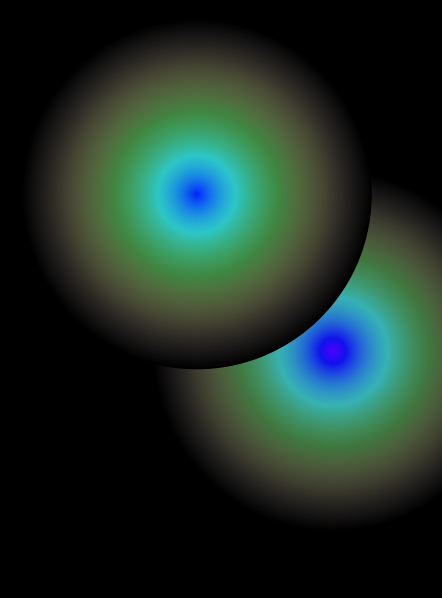

Building the piece from the ground up was a difficult process. We hadn’t worked with any physical components so I had to get a lot of help for working with the Touch Board in Processing. I decided to work in Processing because it felt a lot sturdier for using serial inputs and sound than p5.js, which is what we have been learning to work with over the year. I also had to build a firmware for the board, using cut down versions of an example called MPR121[9]. My biggest issues involved creating more naturalistic visuals than just ellipses on a black background. If I worked on the program more, I would’ve liked to have given the shapes different kinds of forms and sizes, but I lacked a lot of knowledge in Processing. The size of the ellipses was based on the values coming from the board; the harder people pressed the electrode, the larger the shape became. The colours were also based on that value. After some feedback, I could have used less random positioning of the shapes, and more of a calculated position based on other possible factors, such as how many times the same electrode is touched. It would have aided in that aspect of learning the environment. Building the sculptures was an issue due to their size, it took a while to complete them, and they required a lot of work. I used wire, expanding foam, concrete, mod rock and spray paint to finish them. I really liked how they looked however, and also how they felt. I wanted the installation to appear attractive and playful, and I felt that worked well. There were a lot of component issues, as the wire I used to connect the large sculptures to the board had far too high a resistance and allowed for no conductivity. I did have smaller sculptures that worked a lot better and allowed the whole program to function well. It meant that the large sculptures weren’t ‘useful’, but they added a lot of ambience to the piece, and I felt they were always required. I would have put the smaller sculptures on plinths within the areas between the larger sculptures, but I didn’t have the time to make so many plinths on such short notice. In the future, if I were to recreate this work, I would want a larger space, a whole wall for projecting visuals onto, more sculptures and more sophisticated technology used for the touch sensors and programmed visuals, but that kind of knowledge comes with time and experience.
I received a lot of good feedback about my work from fellow artists and my superiors, even though I felt there were so many changes and improvements to make. Most critique was about how the project could be developed further, so overall I think it was quite a successful project despite some big last minute problems with components.
References:
[1] Locke J., An Essay Concerning Human Understanding, Book II, published 2004. http://www.earlymoderntexts.com/assets/pdfs/locke1690book2.pdf
[2] LaCapra D., Writing History, Writing Trauma, Baltimore, MD: Johns Hopkins University Press, published 2001, p 42.
[3] Shaw P., British Library, Discovering Literature: Romantics and Victorians. https://www.bl.uk/romantics-and-victorians/articles/landscape-and-the-sublime
[4] BabyCentre, 2014. https://www.babycentre.co.uk/a544905/toys-for-newborns
[5] Girard, D, Psy.D, Quora, 2014. https://www.quora.com/Developmental-Psychology-Why-do-children-like-colorful-things
[6] Regression. http://www.healthandfitnesstravel.com/insider-interviews/the-benefits-of-hypnotherapy-and-regression-therapy-by-wissam-awad/
[7] clouds + mountains + waterfalls Press Release, Sadie Coles HQ, 2015. http://www.sadiecoles.com/exhibitions-press-release/ugo-rondinone-clouds-mountains-waterfalls-2015
[8] ejtech. http://ejtech.cc
[9] MPR121 GitHub, last commit 2016. https://github.com/BareConductive/mpr121












































































